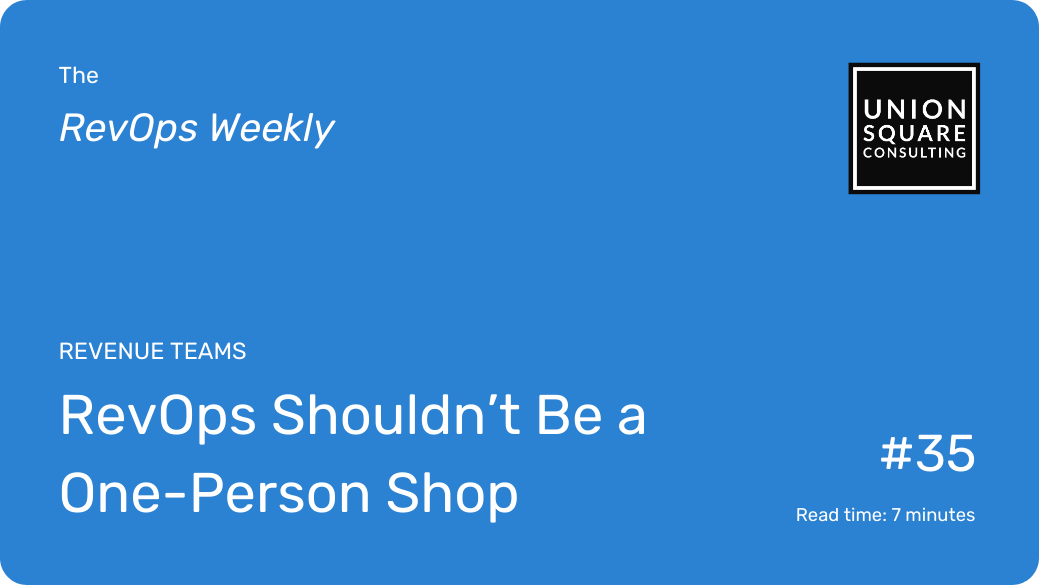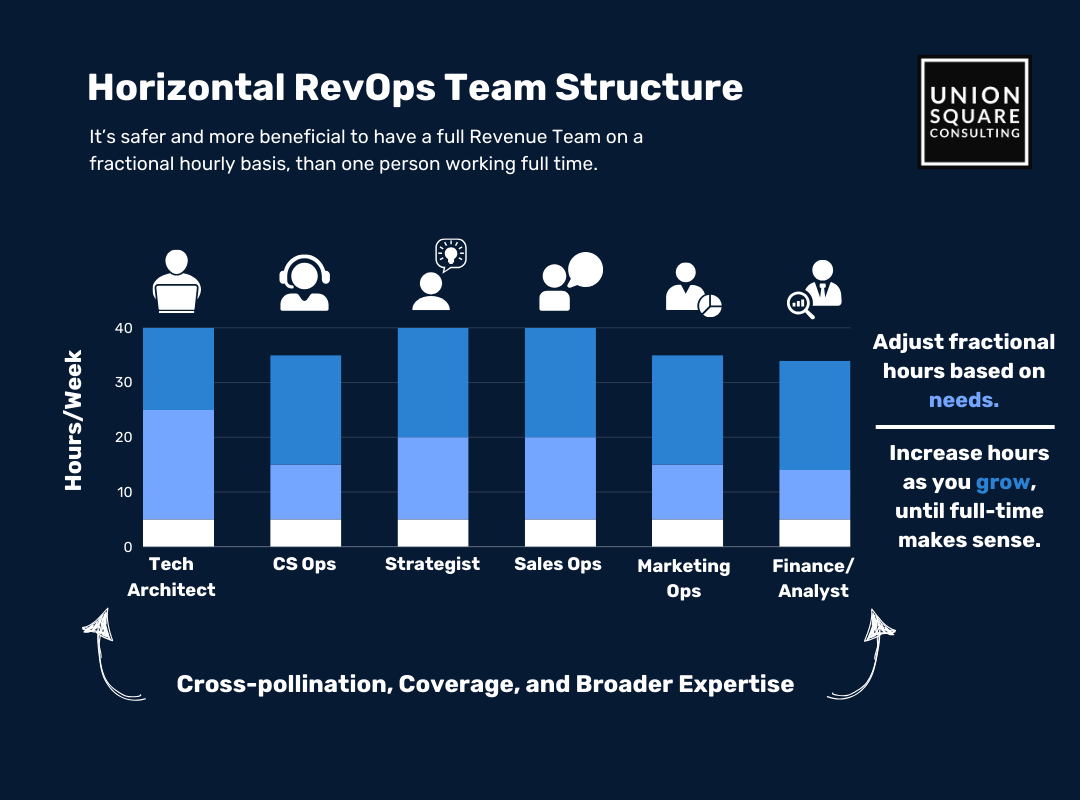
RevOps Shouldn’t Be a One-Person Shop
Read time: 7 minutesIf you’re a RevOps team of one, odds are your bandwidth is maxed out.
Which means Strategic Revenue Operations is likely off the table for your business, putting your organization at risk of technical debt, revenue leakage, and unsustainable growth practices.
Even if you read our last newsletter on building a RevOps roadmap and know exactly how to do it:
- Finding the time to put one together might be impossible
- You’re on your own to get buy-in from the rest of the organization
- There would be no way to implement it, since you’re already at max capacity
- You would need all of the specialized skills of both Strategic and Technical RevOps
At best, you have a checklist of great ideas with no way to implement them. At worst, you’re burning yourself out just trying to put out administrative fires and you have no time to even think about optimizing processes.
The downsides of a one-person RevOps shop don’t stop there.
In this newsletter, we’ll discuss:
- How a one-person team costs you more in the long run
- How it bottlenecks the growth of your business
- Solutions that fit your needs and budget
The Revolving RevOps Door
If there’s only one person on your RevOps team, time off and sick days of course become difficult. But that’s just the beginning.
With zero replacement, any transition becomes dangerous to Business Continuity, potentially taking months to recover. This is key, because having only one RevOps person leads to constant transitioning.
- Promoting Means Hiring: Even if you have a plan to promote your RevOps person within the organization, you don’t have anyone prepared to come in and replace that function. Now you have to worry about hiring. This can be costly and delay things, which means the business might not be motivated to promote at all.
- No Upward Mobility: The more likely scenario is that you don’t have a path to promote that person because you can’t afford to rehire. This turns into a steady stream of people transitioning in and out of that role on a periodic basis because they don’t see potential for growth.
Either way you slice it, you’re likely going to be hiring a new person with no internal knowledge every couple of years, shocking the system each time.
Stunted Company Growth and Burnout
The Knowledge Bottleneck: Your RevOps person is either going to have technical skills or strategic go-to-market business skills – it’s very unlikely you’ll find someone with both.
There is so much to RevOps that, if you miraculously find one person who can do it all, they’ll be so wildly expensive it wouldn’t be worth hiring them anyway. Even if they knew it all, they would never have the time to do it all.
The Experience Bottleneck: If your RevOps person doesn’t have a lot of experience across other businesses like yours, overcoming various challenges at different stages of maturity, then it’s going to be harder for that person to help make decisions.
These experience gaps will make you more susceptible to common pitfalls and unsustainable growth practices as you scale.
Having more people on your team gives you an opportunity to bring in viewpoints and experiences across various industries and at different maturity levels of organizations they may have worked with before.
Burnout: Some companies don’t realize the amount of work that goes into RevOps.
If you only have one person in the RevOps role, they’re juggling liaising between your:
- HR
- Legal
- FP&A
- Analytics
- Accounting
- Tech Vendors
- Product Teams
- CFO/CEO/COO
- Board of Directors
- Accounts Payable
- Marketers/Leaders
- Sales reps/Leaders
- Customer Success reps/Leaders
Plus trying to understand and predict all of their needs, to be proactive versus reactive.
Then, they have to solve for those needs and implement changes inside and outside the tech stack based on them. Whether that means new pieces of software, or modifications and customizations to what you already have.
That’s a lot to take on. Your pace at which you can change is going to be a lot slower.
Or, you’re gonna work them to death and they’re going to burn out very quickly.
What Should Your Team Structure Look Like?
Armed with all of this info, let’s say you get buy-in to expand your RevOps team. How should you actually do that?
You’ll want to think about it horizontally. It’s more important to get several people with a range of experience and skill sets working a few hours a week than to hire one person full-time.
You likely need all of these roles no matter your company size:
- A Tech Architect
- A CS Ops person
- A Strategy person
- A Sales Ops person
- A Marketing Ops person
- A Finance/Analytics person
However, if you’re a smaller company, you may only need each person about 5 hours a week.
As you grow, you can scale these roles to 10 hours, 15 hours, 30 hours, etc. You can start to think about getting full-time people into some of these roles at $15-20M ARR, depending on what makes sense for your business.
Having a bunch of people doing part-time or fractional work is much less dangerous because you have cross-pollination. You have coverage and knowledge across the board.
It’s easier to pull one person out and put a different one in than it is to have one person trying to do all of the roles who doesn’t have the expertise. (And then they leave.)
Thanks to the rise of fractional work, it’s easier than ever to build a team this way.
This is the entire reason that Union Square Consulting exists.
We provide SaaS businesses the breadth of expertise they need across the technical and strategic RevOps disciplines on a fractional basis that suits their size, goals, and budget.
Take a look at our services to see the different ways we can fit into your business.
For teams that just need a little extra guidance, we also offer Weekly Strategic RevOps Coaching with a Senior Revenue Strategist.
Whoever you choose to work with, until your company is large enough to support full-time talent across the board, fractional outsourcing of these roles is the no-brainer solution.
TL;DR
- A RevOps team of one is going to have maxed-out bandwidth
- There will be no upwards mobility due to a lack of a replacement
- This plus burnout will lead to talent churning out every few years
- Company growth is also hamstrung by:
- No depth of experience across different growth maturity levels
- No range of knowledge across all RevOps disciplines
- The solution is to build a horizontal team consisting of:
- A Tech Architect
- A CS Ops Person
- A Sales Ops Person
- A Marketing Ops person
- A Strategy or Finance person
- Each person may only need to work a few hours a week
- The point is that you have a range of talents to draw from
- Fractional contractors are the best option until you can hire full time
- They can work more hours a week as your needs grow
- Union Square Consulting offers this type of fractional work
When you’re ready, here’s how we can help:
Get a Free 1:1 Revenue Efficiency Workshop
Get one of our Senior Revenue Strategists to yourself for 1 hour and leave with a plan to increase the money-making power of your go-to-market operations.
Hire Us!
Bring us on as your Strategic RevOps Team and realize the growth potential of your revenue engine. There are 3 ways to work with us.
Get more tips like these, sent right to your inbox.
Subscribe for fresh, relevant revenue growth tips delivered every week.

